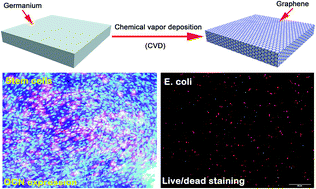Graphene film-functionalized germanium as a chemically stable, electrically conductive, and biologically active substrate†
Abstract
As a microelectronics material, germanium (Ge) has attracted wide interest for semiconductor devices (like biosensors) since its usage to build the first transistor. In this study, large-area monolayer graphene film was directly in situ deposited on a Ge substrate by the chemical vapor deposition (CVD) method. The aim of this study is to explore whether a graphene overlayer on Ge can influence its surface properties. The quality and homogeneity of the graphene film were investigated by Raman spectroscopy and transmission electron microscopy (TEM). The graphene overlayer was demonstrated to act as a protective layer for Ge to improve its corrosion resistance. Compared to bare Ge, graphene film-modified Ge can up-regulate gene expressions of osteogenic markers of mesenchymal stem cells, confirming the enhanced biological activity. Meanwhile, the graphene film also showed good antibacterial ability presumably due to the charge transfer to extract electrons from the bacterial membrane. We hope this work can provide new insights for surface modification and functionalization of Ge-based biosensors and medical devices to better meet clinical needs. The concept of utilizing graphene as a protective, conductive and bioactive layer might provide a viable alternative convenient for further usage of implantable Ge-based biomedical devices.


 Please wait while we load your content...
Please wait while we load your content...